
Alexander Henry Buckley, VC was an Australian recipient of the Victoria Cross, the highest award for gallantry in the face of the enemy that can be awarded to British and Commonwealth forces.
Sergeant Harold Jackson VC was a British Army soldier and an English recipient of the Victoria Cross (VC), the highest and most prestigious award for gallantry in the face of the enemy that can be awarded to British and Commonwealth forces. A soldier with the East Yorkshire Regiment, he was awarded the VC for his actions in March 1918, during the German spring offensive of the First World War. He was killed in action five months later.

Fromelles is a commune in the Nord department in northern France. As of 2019 it had a population of 1,041; its inhabitants are called Fromellois. It is located about 16 kilometres (10 mi) to the west of Lille.
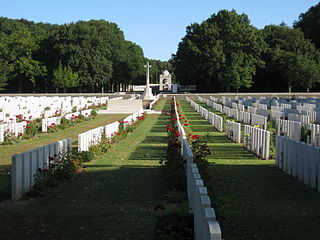
Delville Wood Cemetery is a Commonwealth War Graves Commission cemetery located near Longueval, France and the third largest in the Somme battlefield area.
Adanac Military Cemetery is a Commonwealth War Graves Commission burial ground for the dead of World War I located near the French villages of Miraumont, Pys and Courcelette and contains 3,187 interments, 1483 of whom are identified.

The Pozières Memorial is a World War I memorial, located near the commune of Pozières, in the Somme department of France, and unveiled in August 1930. It lists the names of 14,657 British and South African soldiers of the Fifth and Fourth Armies with no known grave who were killed between 21 March 1918 and 7 August 1918, during the German advance known as the Spring Offensive, and the period of Allied consolidation and recovery that followed. The final date is determined by the start of the period known as the Advance to Victory on 8 August.
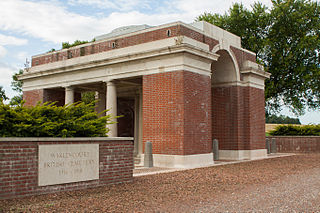
Warlencourt British Cemetery is a Commonwealth War Graves Commission burial ground for military personnel who died on the Western Front during the First World War. It is located in the Pas de Calais region of France. Established in 1919 to consolidate several smaller cemeteries, it was designed by Sir Edward Lutyens and is administered by the Commonwealth War Graves Commission (CWGC). There are 3,450 soldiers interred, over which 1,823 are unidentified. There are also memorials to 55 soldiers whose graves are unknown. The majority of the soldiers who have been identified are British, with smaller numbers of Australians, South Africans, New Zealanders, and Canadians.

Messines Ridge British Cemetery is a Commonwealth War Graves Commission (CWGC) burial ground for the dead of the First World War located in the Ypres Salient in Belgium on the Western Front.
Bancourt British Cemetery is a Commonwealth War Graves Commission burial ground for the dead of the First World War located in the Pas de Calais region of France, on the Western Front.
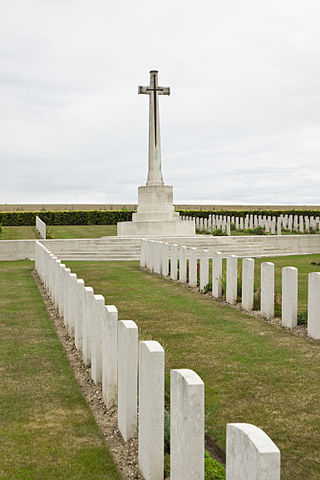
Abbeville Communal Cemetery Extension is a Commonwealth War Graves Commission burial ground for the dead of the First World War and Second World War located near Abbeville, in the Somme region of France. It is adjacent to the Abbeville Communal Cemetery.

Abbeville Communal Cemetery is a Commonwealth War Graves Commission burial ground for the dead of the First World War and Second World War located near Abbeville, in the Somme department of France. It is adjacent to the Abbeville Communal Cemetery Extension.
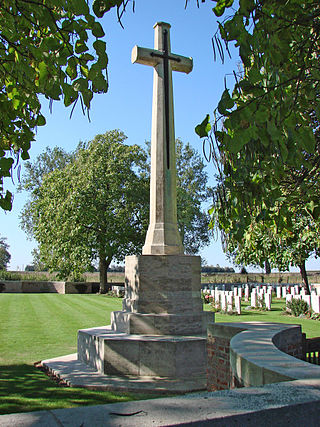
Foncquevillers Military Cemetery is a Commonwealth War Graves Commission burial ground for military personnel who died on the Western Front during the First World War. It is located in the Pas de Calais region of France. Originally established in 1915 by the French military for its soldiers, it was later used for British personnel. Designed by Sir Reginald Blomfield and administered by the Commonwealth War Graves Commission (CWGC), there are 648 soldiers of the First World War interred in the cemetery with 53 of them unidentified. Another four graves are for German soldiers of the First World War, while five Canadian airmen who died in the Second World War and a French civilian are also buried in the cemetery.

Hangard Wood British Cemetery is a Commonwealth War Graves Commission burial ground for the dead of the First World War. It is located near Villers-Bretonneux, in the Somme department of France.
Couin New British Cemetery is a Commonwealth War Graves Commission (CWGC) burial ground for military personnel who died on the Western Front during the First World War. It is located in the Pas de Calais region of France. Established in 1917, it was designed by Sir Reginald Blomfield and is administered by the Commonwealth War Graves Commission. There are 363 soldiers of the First World War interred in the cemetery, including two from Germany.
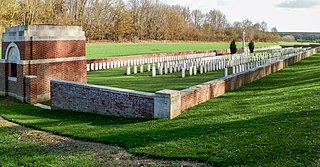
Norfolk Cemetery is a Commonwealth War Graves Commission (CWGC) burial ground for the dead of the First World War. It is located at the village of Bécordel-Bécourt, near Albert in the Somme department of France.

Dantzig Alley British Cemetery is a Commonwealth War Graves Commission burial ground for the dead of the First World War. It is located near the village of Mametz, eight kilometres from Albert in the Somme department of France.
Halfaya Sollum War Cemetery is a burial ground for military personnel who died in Egypt and Libya during the Second World War. It is located in Egypt, near the border with Libya. It is administered by the Commonwealth War Graves Commission. There are 2,046 military personnel of the Second World War interred in the cemetery, including 238 that remain unidentified.
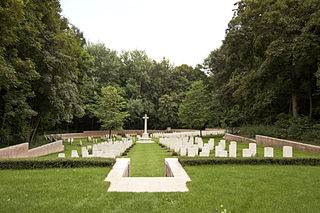
The Aveluy Wood Cemetery is a cemetery located in the Somme region of France commemorating British and Commonwealth soldiers who fought in the Battle of the Somme in World War I. The cemetery honors mainly those who died on the front near Aveluy Wood and the village of Aveluy from June 1916 to February 1917 and from April to September 1918.

The Bulls Road Cemetery is a military cemetery located in the Somme region of France commemorating British and Commonwealth soldiers who fought in the Battle of the Somme in World War I. The cemetery contains mostly those who died manning the front line near the village of Flers between September 1916 and March 1917 and between March 1918 and September 1918. The cemetery is managed by the Commonwealth War Graves Commission.

The Cerisy-Gailly Military Cemetery is a military cemetery located in the Somme region of France commemorating British and Commonwealth soldiers who fought in World War I. The cemetery contains mainly those who died on the front line near the village of Cerisy between February 1917 and March 1918 and during the Allied recapture of the village in August 1918.
















